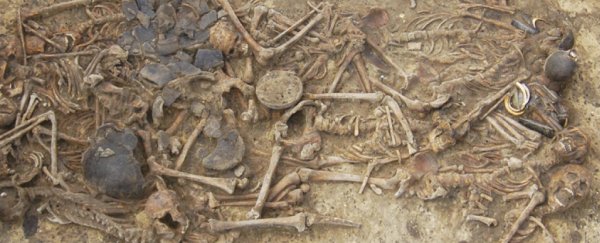A grave of neatly arranged bones near the modern day Polish village of Koszyce captures a tragic moment in history, hinting at a man's return from afar to find his family massacred at the hands of an enemy.
While we can only imagine the personal story that unfolded some 5,000 years ago, a fresh look at the DNA of the skeletons has now provided historians with a new perspective on the meeting of cultures at the dawn of Bronze Age Europe.
Archaeologists uncovered the mass grave containing the bodies of men, women, and children back in 2011, their smashed skulls bearing the hallmarks of a vicious strike to the head.
On closer inspection the bodies were lined up in a rather formal fashion, accompanied by a rich assortment of valuables. This wasn't just a murder scene – it was a funeral in the wake of a massacre.
Based on radio carbon measurements, the bodies were dated to roughly 2880-2776 BCE, a time when Romanian Europe was facing intense cultural upheaval.
The grave goods found at the site suggested the community belonged to the Globular Amphora culture, a group distinguished from their neighbours by their spherical earthenware and tendency to prefer pigs as livestock.
The origins of this central European culture have been the topic of intense debate in recent years, with different models drawing contrasting lines of migration and cultural influence.
As moving populations rub shoulders, trade or tragedy typically follows, leading to questions of whether specific cultural shifts emerge as a result of new settlements, or simply new behaviours borrowed from the neighbours.
Now, a close look at the DNA of the Koszyce grave remains has provided fresh evidence on the ancestry of this Globular Amphora community, while adding new emotional layers to the discovery.
The team compared the genes of the 15 individuals with several ancient genome datasets, including a number from other contemporary sites in southern Poland belonging to the Globular Amphora culture.
Pooling the data together, they confirmed that the Globular Amphora people and a closely related transitional culture called the Złota group were mostly of Neolithic farmer ancestry, with a small amount of western hunter-gatherer thrown in.
Importantly, there were no signs of genes linking them with an influx of populations from the grassy Pontic Steppes far to the east, helping rule out models that suggest members of this culture were descendants of Indo-Iranian migrants.
This has consequences for questions on how Indo-European languages – a branch that includes English, Spanish, Hindustani, Persian, and Russian – spread and evolved.
It also points to a potential culprit for the assault. Expanding populations of migrants transformed the Bronze Age cultural landscape into what became known as the Corded Ware complex.
Given their distinct gene pools, the researchers speculate the relationship between this Globular Amphora community and their Corded Ware neighbours might have been less than friendly.
But on a more intimate level, scientists discovered the victims' bones belonged to members of a few interrelated nuclear families. Four of the women were determined to be mothers to the buried children. Among the men, there were four half-brothers.
More telling still were the positions of the bodies. The oldest individual in the grave was a middle-aged woman who was placed next to her two young sons. A 30- to 35-year-old woman laid next to her teenage daughter and five-year-old son.
This pattern is unlikely to be a coincidence. And on identifying who was missing from the scene, a picture quickly emerges.
The grave is strangely devoid of fathers. A few male bodies are present - one in his late 50s, and another in his early 20s. But the imbalance is otherwise striking.
It seems plausible that the assault was launched while the men were out. Perhaps out in the fields. Maybe trading. Maybe fighting. We'll never know.
What's clear is whoever buried the bodies knew their kindred relationships, placing mothers and children together.
Thousands of years later, we struggle to imagine the kind of world our ancestors lived in. This one heartbreaking scene reminds us just how little some things change.
This research was published in PNAS.
